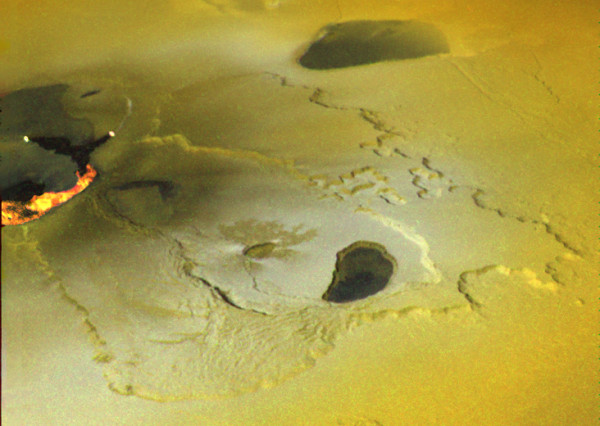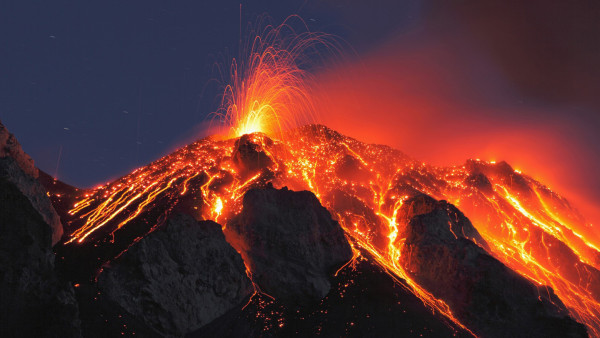“The crust, being so thin, must bend, if, over wide areas, it becomes loaded with glacial ice, ocean water or deposits of sand and mud. It must bend in the opposite sense if widely extended loads of such material be removed. This accounts for… the origin of chains of high mountains… and the rise of lava to the earth’s surface.” -Reginald Daly, 1932
When you think about volcanoes, you quite likely think about magma -- liquid rock -- accumulating and welling up beneath the Earth's surface. Every once in a while, this ultra-hot liquid seeps through the Earth's surface, resulting in a spectacular eruption.
Earth is the largest, most massive and most volcanically active rocky world in the Solar System, which is what you'd expect if the other planets are smaller and have less internal energy. Except I lied; there's one world in the Solar System that's so volcanically active that it has no craters on its surface, because it's constantly flowing with magma.
 Image credit: NASA Planetary Photojournal, via https://solarsystem.nasa.gov/multimedia/display.cfm?IM_ID=2155.
Image credit: NASA Planetary Photojournal, via https://solarsystem.nasa.gov/multimedia/display.cfm?IM_ID=2155.
Come and meet Jupiter's closest Moon, Io, and learn the story of how Jupiter acts like a cosmic zamboni, resurfacing it on a continuous basis.


With Jupiter's day only being about 10 hours, and Io's orbital period being 42 hours, is Io moving away from Jupiter the same way the moon is moving away from the Earth? If so, do all of Jupiter's moon move away from Jupiter at the same rate, or could some of the moons potentially impact each other as they migrated to ever higher orbits?
The moon is moving away because they are very close to our size and create a bulge that inserts the ability to create a torque on the earth and therefore siphon off energy.
Since Io is a peanut compared to the whale of Jupiter, there's no similar mechanism.
The other moons will, like the plants, "want" to attain a resonant orbital relationship with the OTHER moons. The mechanism and result is exactly the same as with the planets in orbit around the sun.
And the same level of lax conformance.
The fact that significant energy is being dissipated as heat on Io, means there has to be considerable tidal drag. Energy and angular momentum have to be conserved, and angular momentum is being transferred from Jupiter to Io, whilst the rotational kinetic energy being lost from Jupiter is not fully matched by the increase in orbital energy of Io. The remainder is heat, largely inside Io.
Aye, but a different effect and a different result.
Io will fall in.
Luna is "falling out".
Interestingly, like our Moon Io is in tidal lock; Io rotates around its axis with the same period as its orbit around Jupiter.
As mentioned by Ethan: besides the tides of the oceans the Earth has a solid Earth tide as it rotates relative to the Sun and Moon.
Io doesn't have that kind of tide, as Io is in tidal lock. In the case of Io the periodic deformation is due to the fact that Io's orbit is not quite circular. As Io moves closer and further away from Jupiter the magnitude of Jupiter's tidal effect changes.
The wikipedia article about Io also mentions that the change in tidal bulge from closest-to-Jupiter to farthest away may be as much as 100 meters (the radius of Io is about 1800 kilometer)
The amount of change of tidal bulge causes internal deformation, the friction heats Io up.
I wonder: is the amount of tidal bulge change large enough to crack Io's surface? I estimate it's still within the range of elastic deformation. (Just as on earth a rock surface does not necessarily crack when there is an earthquake. Mostly the size of the seismic waves is within the range of elastic deformation that the rock is capable of.)
Of course, the surface of Io is continuously cracked allright: by vulcanism.
"I wonder: is the amount of tidal bulge change large enough to crack Io’s surface?"
An engineer would be able to answer, but I know how you would answer it yourself.
The 100m is over half the surface. So what is the deformation per unit length, and what is the stress limit of the material you can assign to the surface of IO compared to that?